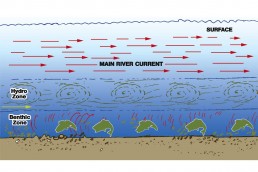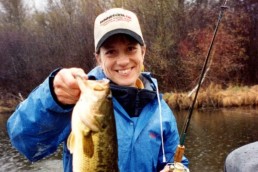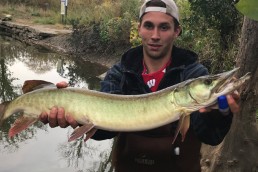SHARE THIS POST
“Bobber” Anne and I have continued to seek out further information on river bottom zones. We’ve nailed down the fact that carp and suckers can be caught using Flick Flies out of these bottom Benthic Zones. But another fact we’ve found is that the Hydro Zones found in the Mississippi, St. Croix, Rock and Ohio rivers, and other larger rivers, is where a great deal of rocky structure is found, making these more ideal for such areas.
The Benthic Zone is an important factor, yes, but rivers which host the Hydro Zones are ideal for an angler’s presentation. And when you have these Hydro Zones, the staging of all fish seems to be deeper in the Benthic Zones. Thus, working a presentation closer to the bottom is critical. (See diagram.)
How do you recognize when a river has a Hydro Zone?
One way is to closely watch your graph or electric fish finder. If the fish blips are all within 6 to 10 inches of the bottom, there’s likely a Hydro Zone above the Benthic Zone. Next, if fish blips are seen to rise above the Benthic Zone, swimming erratic paths as they come and go above the narrow bottom zone, there is a Hydro Zone. And finally, if a river has a great deal of rocky rapids, especially larger rocks or boulders, there is such a zone.
It’s the rocky rivers that always seem to host the Hydro Zones. If you know you’re working a river with two bottom zones, it then forces you to present lures tight on the bottom where large gamefish hole up. This is where the river’s rough fish are staging. Also, it’s not a situation where you won’t catch any fish if your presentation wanders up into the Hydro Zone. However, unfortunately, 95 percent of the fish you catch above the Benthic Zone will be small. Our research proved that higher presentations caught the 1/2- to 1-pound smallmouths, 1/2-pound walleyes and 6- to 10-inch trout. All those 7- to 10-pound brown trout you’re after hold tight to the bottom where current rush doesn’t affect them as much. And if you’re a steelheader, it’s critical to remember to present your fly down just off the bottom.
As mentioned in previous issues, all rough fish are prone to suck in the food they prey on. And on “Bobber” Anne’s underwater video gear, we became critically aware of why anglers have had such a difficult time hooking up suckers, in particular. Carp sometimes also possess these traits. Baits, about 95 percent of the time, are then approached very slowly. Once one is over it, they will hold onto bait in their mouths as if they’re testing it for taste. Then, the lure or bait is sucked into the first part of their accordion-like mouths. This is when the angler now feels that first tap—he must hold off setting the hook. That angler must now count to three, pausing before setting a hook. If he can do this, he’ll hook up 80 percent of his sucker strikes and 95 percent of his carp strikes.
It’s that little pause which makes an angler a proven rough fisherman. On underwater film, we watched suckers in particular blow out 50 to 80 percent of the strikes when the angler sets the hook on the first tap. Those mouths seemed to be extremely sensitive, and fish were able to smell and sense the weight of artificials over 1/64 ounce. And if you read last year’s series of articles on Gapen’s Spin Bee, you will recall that our catch on rough fish failed to “mature” until we came out with a 1/32-ounce-sized lure. Even then we had difficulty on hook-ups, with a success rate of less than 50 percent on suckers. Thus, the reason we came out with the Flick Fly.
Also worth repeating are the redhorse suckers, which hosted a hard fight. In similar fashion to the rainbow trout, they broke water, cartwheeled and dug deep in a bulldog manner. Some of you have called the company and complained I didn’t give you enough how-to in the third part of the Spin Bee series on salmon, trout, muskies and pike in these zones.
Are you enjoying this post?
You can be among the first to get the latest info on where to go, what to use and how to use it!
Maybe the following will help:
“Bobber” Anne and I spent several days in March 2015 fishing the streams entering Lake Erie on its southern shore. We used fly rods, but I’m sure you could use spinning gear just as easily. Our targets were the steelhead that migrate up these streams in early spring. For the most part, we used the 1/32-ounce Spin Bee. Our presentation was similar for what you’d use with an egg sack fly. With the streams as clear as they were, we used a spot-and-stalk approach. But it was easy, as most steelhead we landed were between 5 and 10 pounds. I lost count of the number, but it must’ve been 50 landed and released. That particular fishing was the easiest of the trout species we had worked during our research. One other thing is that the scented Red Ball eggs were tipped on each nymph-style Spin Bee. When it came to salmon research (cohos, kings), we used the 1/16- and 1/8-ounce Spin Bee jig while trolling both flat lining and down-rigging out of the port of Waukegan on Lake Michigan. Mostly, the 1/16- 1/8- and 1/4-ounce sizes were used. On the smaller sizes, we landed mostly small 3-year-old cohos. On the 1/8 and 1/4 ounce for the Spin Bees, steelhead and kings were caught. But we were actually surprised by the number of larger cohos and kings caught on the smaller-sized Bees.
I took a number of pike casting the 1/4- and 3/8-ounce sizes for the Flick Fly. These were either taken by sight-fishing or by working the cabbage weeds in 10 feet of water during the summer 2015 and in 2016. Here, we also were testing the Flick Fly, which produced well. No muskies were caught, except the one Anne showed you in the March MidWest Outdoors this year.
We did fish several rivers where huge boulders helped make up the rapids. Here, Benthic Zones had their beginnings at the rock’s base, which continued up to the boulder’s top, or near it. In many instances, we found both bass and walleyes staging in the nearby 3-foot zones where they ambushed prey and our presentations of Flick Flies. Though the boulder created the zone here, it soon dropped down to the normal 6- to 8-inch depth as you worked downstream from the boulder-strewn rapids. One other thing about these boulder zones—there was no Hydro Zone above them, just a deep Benthic Zone where Anne filmed hellgrammites, fly larvae, crawfish and schools of minnows. These would suddenly disappear as a walleye or bass swam into the structure.
One dead oak, which had dropped into the Fox River as a victim of bank erosion, produced a deep zone that lasted for nearly 100 feet downstream. At its beginning it was nearly 2 feet deep and was as wide as the length of the tree laydown which created it. But shortly after it dropped down to about 9 inches.
Now you know the fact that certain objects in a river can create a Benthic Zone; this is new information. However, out from a tree-formed zone on a river like the Fox, there can be several other 4- to 6-inch bottom zones where fish have been and are caught. The “tree zone” mostly supported smaller bass and rough fish. It was also in an onshore area and was available to wading or shoreline anglers.
“Bobber” Anne and I will keep researching and give you more of our findings in future articles.
MWO
SHARE THIS POST
Did you enjoy this post?
You can be among the first to get the latest info on where to go, what to use and how to use it!
Dan Gapen
Considered one of the world’s leading river anglers, Dan Gapen, Sr. has shared his knowledge with MidWest Outdoors readers and viewers for more than 40 years. He is a member of all three Fishing Halls of Fame—International, National Freshwater, and Minnesota. He has an immense grasp of the world’s fisheries. He may be contacted at 877-623-2099.
@TheGapenCompany.


